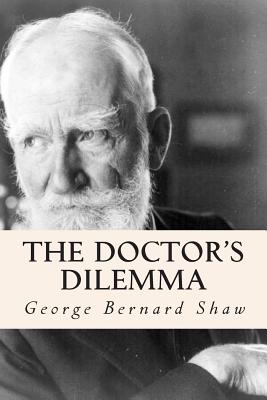The Doctor's Dilemma

The Doctor's Dilemma
The Doctor's Dilemma is a play by George Bernard Shaw first staged in 1906. It is a problem play about the moral dilemmas created by limited medical resources, and the conflicts between the demands of private medicine as a business and a vocation.The eponymous dilemma of the play is that of the newly honoured doctor Sir Colenso Ridgeon, who has developed a revolutionary new cure for tuberculosis. However, his private medical practice, with limited staff and resources, can only treat ten patients at a time. From a selection of fifty patients he has selected ten he believes he can cure and who, he believes, are most worthy of being saved. However, when he is approached by a young woman, Jennifer Dubedat, with a deadly ill husband, Louis Dubedat, he admits he can, at a stretch, save one more patient, but that the individual in question must be shown to be most worthy of being saved. However, the situation is complicated when an old friend and colleague reveals, he too, needs treatment. Sir Colenso must choose which patient he will save: a kindly, altruistic poor medical colleague, or an extremely gifted but also very unpleasant, womaniser, bigamist and amoral young artist. Sir Colenso falls instantly in love with the young and vivacious Mrs Dubedat and this makes it even harder for the doctor to separate his motives for the decision of who shall live.The extensive preface to the play points out that there is another dilemma: poor doctors are easily tempted to perform costly but useless (and in the best case harmless) operations or treatments on their patients for personal gain. "Could I not make a better use of a pocketful of guineas than this man is making of his leg?" This was reportedly inspired by the behaviour of a prominent Ear Nose and Throat specialist in London who had developed a simple and almost harmless operation to remove the uvula. This did not benefit any of his patients but made the surgeon a great deal of money.Shaw credits Almroth Wright as the source of his information on medical science: "It will be evident to all experts that my play could not have been written but for the work done by Sir Alm[r]oth Wright on the theory and practice of securing immunization from bacterial diseases by the inoculation of vaccines made of their own bacteria."The play also mentions (then) new developments in the germ theory of disease, namely opsonins, and included socialist and anti-vivisectionist viewpoints. Specifically, it could be considered as advo
PRP: 46.42 Lei
Acesta este Pretul Recomandat de Producator. Pretul de vanzare al produsului este afisat mai jos.
41.78Lei
41.78Lei
46.42 LeiIndisponibil
Descrierea produsului
The Doctor's Dilemma is a play by George Bernard Shaw first staged in 1906. It is a problem play about the moral dilemmas created by limited medical resources, and the conflicts between the demands of private medicine as a business and a vocation.The eponymous dilemma of the play is that of the newly honoured doctor Sir Colenso Ridgeon, who has developed a revolutionary new cure for tuberculosis. However, his private medical practice, with limited staff and resources, can only treat ten patients at a time. From a selection of fifty patients he has selected ten he believes he can cure and who, he believes, are most worthy of being saved. However, when he is approached by a young woman, Jennifer Dubedat, with a deadly ill husband, Louis Dubedat, he admits he can, at a stretch, save one more patient, but that the individual in question must be shown to be most worthy of being saved. However, the situation is complicated when an old friend and colleague reveals, he too, needs treatment. Sir Colenso must choose which patient he will save: a kindly, altruistic poor medical colleague, or an extremely gifted but also very unpleasant, womaniser, bigamist and amoral young artist. Sir Colenso falls instantly in love with the young and vivacious Mrs Dubedat and this makes it even harder for the doctor to separate his motives for the decision of who shall live.The extensive preface to the play points out that there is another dilemma: poor doctors are easily tempted to perform costly but useless (and in the best case harmless) operations or treatments on their patients for personal gain. "Could I not make a better use of a pocketful of guineas than this man is making of his leg?" This was reportedly inspired by the behaviour of a prominent Ear Nose and Throat specialist in London who had developed a simple and almost harmless operation to remove the uvula. This did not benefit any of his patients but made the surgeon a great deal of money.Shaw credits Almroth Wright as the source of his information on medical science: "It will be evident to all experts that my play could not have been written but for the work done by Sir Alm[r]oth Wright on the theory and practice of securing immunization from bacterial diseases by the inoculation of vaccines made of their own bacteria."The play also mentions (then) new developments in the germ theory of disease, namely opsonins, and included socialist and anti-vivisectionist viewpoints. Specifically, it could be considered as advo
Detaliile produsului








